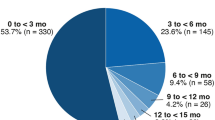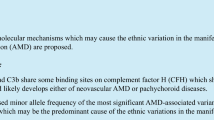Abstract
Serum C-reactive protein (CRP), an important inflammatory marker, has been associated with age-related macular degeneration (AMD) in observational studies; however, the findings are inconsistent. It remains unclear whether the association between circulating CRP levels and AMD is causal. We used two-sample Mendelian randomization (MR) to evaluate the potential causal relationship between serum CRP levels and AMD risk. We derived genetic instruments for serum CRP levels in 418,642 participants of European ancestry from UK Biobank, and then conducted a genome-wide association study for 12,711 advanced AMD cases and 14,590 controls of European descent from the International AMD Genomics Consortium. Genetic variants which predicted elevated serum CRP levels were associated with advanced AMD (odds ratio [OR] for per standard deviation increase in serum CRP levels: 1.31, 95% confidence interval [CI]: 1.19–1.44, P = 5.2 × 10−8). The OR for the increase in advanced AMD risk when moving from low (< 3 mg/L) to high (> 3 mg/L) CRP levels is 1.29 (95% CI: 1.17–1.41). Our results were unchanged in sensitivity analyses using MR models which make different modelling assumptions. Our findings were broadly similar across the different forms of AMD (intermediate AMD, choroidal neovascularization, and geographic atrophy). We used multivariable MR to adjust for the effects of other potential AMD risk factors including smoking, body mass index, blood pressure and cholesterol; this did not alter our findings. Our study provides strong genetic evidence that higher circulating CRP levels lead to increases in risk for all forms of AMD. These findings highlight the potential utility for using circulating CRP as a biomarker in future trials aimed at modulating AMD risk via systemic therapies.

Similar content being viewed by others
References
Mitchell P, Liew G, Gopinath B, Wong TY. Age-related macular degeneration. Lancet. 2018;392(10153):1147–59.
Friedman DS, O’Colmain BJ, Muñoz B, et al. Prevalence of age-related macular degeneration in the United States. Arch Ophthalmol. 2004;122(4):564–72.
Klein R, Klein BE, Cruickshanks KJ. The prevalence of age-related maculopathy by geographic region and ethnicity. Prog Retin Eye Res. 1999;18(3):371–89.
Mitchell P, Smith W, Attebo K, Wang JJ. Prevalence of age-related maculopathy in Australia: the blue mountains eye study. Ophthalmology. 1995;102(10):1450–60.
Wong WL, Su X, Li X, et al. Global prevalence of age-related macular degeneration and disease burden projection for 2020 and 2040: a systematic review and meta-analysis. Lancet Global Health. 2014;2(2):e106–16.
Fritsche LG, Igl W, Bailey JNC, et al. A large genome-wide association study of age-related macular degeneration highlights contributions of rare and common variants. Nat Genet. 2016;48(2):134–43. https://doi.org/10.1038/ng.3448.
Kauppinen A, Paterno JJ, Blasiak J, Salminen A, Kaarniranta K. Inflammation and its role in age-related macular degeneration. Cell Mol Life Sci. 2016;73(9):1765–86.
Molins B, Romero-Vázquez S, Fuentes-Prior P, Adan A, Dick AD. C-reactive protein as a therapeutic target in age-related macular degeneration. Front Immunol. 2018;19(9):808.
Fritsche LG, Chen W, Schu M, et al. Seven new loci associated with age-related macular degeneration. Nat Genet. 2013;45(4):433–9, 439e1–2.
Pepys MB, Hirschfield GM. C-reactive protein: a critical update. J Clin Invest. 2003;111(12):1805–12.
Seddon JM, Gensler G, Milton RC, Klein ML, Rifai N. Association between C-reactive protein and age-related macular degeneration. JAMA. 2004;291(6):704–10.
Seddon JM, George S, Rosner B, Rifai N. Progression of age-related macular degeneration: prospective assessment of C-reactive protein, interleukin 6, and other cardiovascular biomarkers. Arch Ophthalmol. 2005;123(6):774–82.
McGwin G, Hall TA, Xie A, Owsley C. The relation between C reactive protein and age related macular degeneration in the cardiovascular health study. Br J Ophthalmol. 2005;89(9):1166–70.
Wu KHC, Tan AG, Rochtchina E, et al. Circulating inflammatory markers and hemostatic factors in age-related maculopathy: a population-based case-control study. Invest Ophthalmol Vis Sci. 2007;48(5):1983–8.
Klein R, Knudtson MD, Klein BEK, et al. Inflammation, complement factor h, and age-related macular degeneration: the multi-ethnic study of Atherosclerosis. Ophthalmology. 2008;115(10):1742–9.
Hong T, Tan AG, Mitchell P, Wang JJ. A review and meta-analysis of the association between C-reactive protein and age-related macular degeneration. Surv Ophthalmol. 2011;56(3):184–94.
Mitta VP, Christen WG, Glynn RJ, et al. C-reactive protein and the incidence of macular degeneration: pooled analysis of 5 cohorts. JAMA Ophthalmol. 2013;131(4):507–13.
Yip JLY, Khawaja AP, Chan MPY, et al. Cross sectional and longitudinal associations between cardiovascular risk factors and age related macular degeneration in the EPIC-Norfolk eye study. PLoS ONE. 2015;10(7):e0132565.
Despriet DDG, Klaver CCW, Witteman JCM, et al. Complement factor H polymorphism, complement activators, and risk of age-related macular degeneration. JAMA. 2006;296(3):301–9.
Schaumberg DA, Christen WG, Kozlowski P, Miller DT, Ridker PM, Zee RYL. A prospective assessment of the Y402H variant in complement factor H, genetic variants in C-reactive protein, and risk of age-related macular degeneration. Invest Ophthalmol Vis Sci. 2006;47(6):2336–40.
Kim IK, Ji F, Morrison MA, et al. Comprehensive analysis of CRP, CFH Y402H and environmental risk factors on risk of neovascular age-related macular degeneration. Mol Vis. 2008;11(14):1487–95.
Cipriani V, Hogg RE, Sofat R, et al. Association of C-reactive protein genetic polymorphisms with late age-related macular degeneration. JAMA Ophthalmol. 2017;135(9):909–16.
Davies NM, Holmes MV, Davey Smith G. Reading Mendelian randomisation studies: a guide, glossary, and checklist for clinicians. BMJ. 2018;12(362):k601.
Pingault J-B, O’Reilly PF, Schoeler T, Ploubidis GB, Rijsdijk F, Dudbridge F. Using genetic data to strengthen causal inference in observational research. Nat Rev Genet. 2018;19(9):566–80.
Davey Smith G, Hemani G. Mendelian randomization: genetic anchors for causal inference in epidemiological studies. Hum Mol Genet. 2014;23(R1):R89–98.
Bycroft C, Freeman C, Petkova D, Band G, Elliott LT, Sharp K, et al. The UK Biobank resource with deep phenotyping and genomic data. Nature. 2018;562:203–9.
Loh P-R, Tucker G, Bulik-Sullivan BK, et al. Efficient Bayesian mixed-model analysis increases association power in large cohorts. Nat Genet. 2015;47(3):284–90.
Purcell S, Neale B, Todd-Brown K, et al. PLINK: a tool set for whole-genome association and population-based linkage analyses. Am J Hum Genet. 2007;81(3):559–75.
Ligthart S, Vaez A, Võsa U, et al. Genome analyses of > 200,000 individuals identify 58 Loci for chronic inflammation and highlight pathways that link inflammation and complex disorders. Am J Hum Genet. 2018;103(5):691–706.
Howie B, Fuchsberger C, Stephens M, Marchini J, Abecasis GR. Fast and accurate genotype imputation in genome-wide association studies through pre-phasing. Nat Genet. 2012;44(8):955–9.
Brion M-JA, Shakhbazov K, Visscher PM. Calculating statistical power in Mendelian randomization studies. Int J Epidemiol. 2013;42(5):1497–501.
Burgess S, Butterworth A, Thompson SG. Mendelian randomization analysis with multiple genetic variants using summarized data. Genet Epidemiol. 2013;37(7):658–65.
Burgess S, Scott RA, Timpson NJ, Davey Smith G, Thompson SG. EPIC- InterAct consortium. Using published data in Mendelian randomization: a blueprint for efficient identification of causal risk factors. Eur J Epidemiol. 2015;30(7):543–52.
Burgess S, Thompson SG. Interpreting findings from Mendelian randomization using the MR-Egger method. Eur J Epidemiol. 2017;32(5):377–89.
Bowden J, Del Greco MF, Minelli C, Davey Smith G, Sheehan N, Thompson J. A framework for the investigation of pleiotropy in two-sample summary data Mendelian randomization. Stat Med. 2017;36(11):1783–802.
Bowden J, Davey Smith G, Burgess S. Mendelian randomization with invalid instruments: effect estimation and bias detection through Egger regression. Int J Epidemiol. 2015;44(2):512–25.
Burgess S, Bowden J, Fall T, Ingelsson E, Thompson SG. Sensitivity analyses for robust causal inference from mendelian randomization analyses with multiple genetic variants. Epidemiology. 2017;28(1):30–42.
Verbanck M, Chen C-Y, Neale B, Do R. Detection of widespread horizontal pleiotropy in causal relationships inferred from Mendelian randomization between complex traits and diseases. Nat Genet. 2018;50(5):693–8.
Burgess S, Thompson SG. Multivariable Mendelian randomization: the use of pleiotropic genetic variants to estimate causal effects. Am J Epidemiol. 2015;181(4):251–60.
Hemani G, Zheng J, Elsworth B, et al. The MR-Base platform supports systematic causal inference across the human phenome. Elife [Internet]. 2018. https://doi.org/10.7554/eLife.34408.
Sanderson E, Smith GD, Windmeijer F, Bowden J. An examination of multivariable Mendelian randomization in the single-sample and two-sample summary data settings [Internet]. Int J Epidemiol. 2018. https://doi.org/10.1093/ije/dyy262.
Burgess S, Thompson DJ, Rees JMB, Day FR, Perry JR, Ong KK. Dissecting causal pathways using Mendelian randomization with summarized genetic data: application to age at menarche and risk of breast cancer. Genetics. 2017;207(2):481–7.
Yavorska OO, Burgess S. MendelianRandomization: an R package for performing Mendelian randomization analyses using summarized data. Int J Epidemiol. 2017;46(6):1734–9.
R Core Team. R: A Language and Environment for Statistical Computing [Internet]. Vienna, Austria: R Foundation for Statistical Computing; 2017. Available from: https://www.R-project.org/. Accessed 1 Apr 2019.
Bowden J, Davey Smith G, Haycock PC, Burgess S. Consistent estimation in Mendelian randomization with some invalid instruments using a weighted median estimator. Genet Epidemiol. 2016;40(4):304–14.
Acknowledgements
This work was conducted using the UK Biobank Resource (application number 25331). For the AMD datasets, all contributing sites and additional funding information are acknowledged in this publication: Fritsche et al. [6]; The International AMD Genomics consortium’s web page is: http://eaglep.case.edu/iamdgc_web/, and additional information is available on: http://csg.sph.umich.edu/abecasis/public/amd2015/. The AMD case-control datasets used for the analyses described in this manuscript were obtained from the NEI Study of Age-Related Macular Degeneration (NEI-AMD) Database found at https://www.ncbi.nlm.nih.gov/projects/gap/cgi-bin/study.cgi?study_id=phs001039.v1.p1 through dbGaP accession number 20740. Funding support for NEI-AMD was provided by the National Eye Institute. We would like to thank NEI-AMD participants and the NEI-AMD Research Group for their valuable contribution to this research. SM and AWH are supported by Australian National Health and Medical Research Council (NHMRC) Fellowships. XH is supported by the University of Queensland Research Training Scholarship and QIMR Berghofer PhD Top Up Scholarship. We acknowledge funding from NHMRC Grants [1116360, 1150144 and 1123248]. The authors thank all of the participants who took part in the UK Biobank and the International AMD Genomics Consortium and support staff who made this study possible. We thank Scott Wood, Xiaping Lin, and John Pearson from QIMR Berghofer for IT support.
Author information
Authors and Affiliations
Corresponding author
Ethics declarations
Conflict of interest
The authors have declared that no competing interests exist.
Additional information
Publisher's Note
Springer Nature remains neutral with regard to jurisdictional claims in published maps and institutional affiliations.
Electronic supplementary material
Below is the link to the electronic supplementary material.
Rights and permissions
About this article
Cite this article
Han, X., Ong, JS., An, J. et al. Using Mendelian randomization to evaluate the causal relationship between serum C-reactive protein levels and age-related macular degeneration. Eur J Epidemiol 35, 139–146 (2020). https://doi.org/10.1007/s10654-019-00598-z
Received:
Accepted:
Published:
Issue Date:
DOI: https://doi.org/10.1007/s10654-019-00598-z




